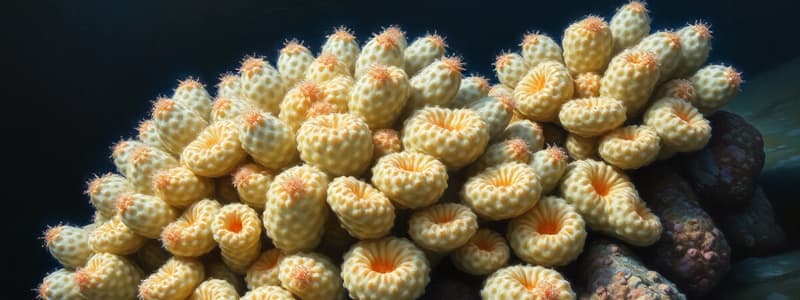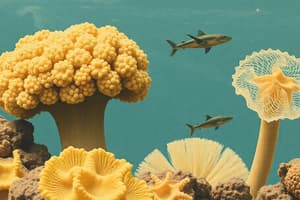Podcast
Questions and Answers
To what phylum do sponges belong?
To what phylum do sponges belong?
Phylum Porifera
Sponges have muscles.
Sponges have muscles.
False (B)
Sponges are metazoans.
Sponges are metazoans.
True (A)
How many species of sponges have been described to date?
How many species of sponges have been described to date?
How many classes of sponges are there now?
How many classes of sponges are there now?
Which of the following is NOT a class of sponges?
Which of the following is NOT a class of sponges?
What material are the spicules in Class Calcarea made of?
What material are the spicules in Class Calcarea made of?
What is a unique feature of the class Hexactinellida?
What is a unique feature of the class Hexactinellida?
Spicules in Class Demospongiae are never 6 rayed (triaxon).
Spicules in Class Demospongiae are never 6 rayed (triaxon).
What is the most recent addition to the classes of sponges, based on genetics, morphology, and embryology?
What is the most recent addition to the classes of sponges, based on genetics, morphology, and embryology?
What two attributes define sponges and played huge roles in their success?
What two attributes define sponges and played huge roles in their success?
What is the aquiferous system's jack of all trades?
What is the aquiferous system's jack of all trades?
What is the outer surface of a sponge called?
What is the outer surface of a sponge called?
What is the middle layer of a sponge called?
What is the middle layer of a sponge called?
Archaeocytes are totipotent
Archaeocytes are totipotent
What cells disintegrate after a spicule is formed?
What cells disintegrate after a spicule is formed?
In freshwater sponges, what structure is produced for asexual reproduction?
In freshwater sponges, what structure is produced for asexual reproduction?
Most sponges are hermaphrodites producing both eggs and sperm but at different times.
Most sponges are hermaphrodites producing both eggs and sperm but at different times.
What is a Parenchymella?
What is a Parenchymella?
Flashcards
Phylum Porifera
Phylum Porifera
Animals belonging to the phylum Porifera, characterized by having pores.
Sponge Characteristics
Sponge Characteristics
Multicellular, heterotrophic, and mobile as larvae.
Collagen in Sponges
Collagen in Sponges
Protein found exclusively in animals, including sponges.
Sponge Phylogeny
Sponge Phylogeny
Signup and view all the flashcards
Sponge Habitat
Sponge Habitat
Signup and view all the flashcards
Classes of Sponges
Classes of Sponges
Signup and view all the flashcards
Class Calcarea characteristics
Class Calcarea characteristics
Signup and view all the flashcards
Class Hexactinellida
Class Hexactinellida
Signup and view all the flashcards
Class Demospongiae
Class Demospongiae
Signup and view all the flashcards
Class Homoscleromorpha
Class Homoscleromorpha
Signup and view all the flashcards
Unique Sponge Attributes
Unique Sponge Attributes
Signup and view all the flashcards
Aquiferous System
Aquiferous System
Signup and view all the flashcards
Ostia
Ostia
Signup and view all the flashcards
Osculum
Osculum
Signup and view all the flashcards
Pinacocytes
Pinacocytes
Signup and view all the flashcards
Choanocytes
Choanocytes
Signup and view all the flashcards
Mesohyl
Mesohyl
Signup and view all the flashcards
Archaeocytes
Archaeocytes
Signup and view all the flashcards
Asconoid Sponge
Asconoid Sponge
Signup and view all the flashcards
Syconoid Sponge
Syconoid Sponge
Signup and view all the flashcards
Leuconoid Sponge
Leuconoid Sponge
Signup and view all the flashcards
Sclerocytes
Sclerocytes
Signup and view all the flashcards
Spongin
Spongin
Signup and view all the flashcards
Asexual Sponge Reproduction
Asexual Sponge Reproduction
Signup and view all the flashcards
Gemmules
Gemmules
Signup and view all the flashcards
Sponge Sexual Reproduction
Sponge Sexual Reproduction
Signup and view all the flashcards
Parenchymella Larva
Parenchymella Larva
Signup and view all the flashcards
Sponge Environmental Resistance
Sponge Environmental Resistance
Signup and view all the flashcards
Biochemical Defenses
Biochemical Defenses
Signup and view all the flashcards
Siphonodictyon sp.
Siphonodictyon sp.
Signup and view all the flashcards
Study Notes
- Sponges belong to the Phylum Porifera, which means "pore bearers"
General Sponge Characteristics
- Sponges appear simple and may seem out of place among metazoans
- Sponges lack muscles, a digestive tract, a conventional nervous system, typical metazoan organs, and obvious anterior-posterior polarity
- Sponges possess choanocytes, which are characteristic of many protists
- Sponges are indeed metazoans, exhibiting multicellularity, heterotrophic nutrition, and mobility as larvae
- They reproduce sexually with sperm and egg, resulting in an embryo that grows via cleavage to produce a multilayered larva
- Sponges contain collagen, a protein found only in animals
- Molecular genetic analysis places sponges in the metazoan group as a monophyletic group
- Sponge genes have been found to be responsible for the anterior-posterior polarization of other basal metazoans
Sponge Distribution
- Approximately 9000 living species of sponges have been described, with about 60 new species described each year
- 8800 sponge species are marine
- Sponges occur at all depths
- Sponges are most abundantly found in tropical reefs, continental shelves, and the Polar regions
- 200 freshwater sponge species can be found from sea level to alpine lakes, deserts, and rainforests
- Antarctic sponges can constitute up to 75% of benthic biomass
Sponge Taxonomy
- Traditionally, there were 3 classes of sponges: Calcarea, Hexactinellida, and Demospongia
- Recent genetic analysis led to the creation of another group, removed from Demospongia
- There are now 4 classes of sponges: Calcarea, Hexactinellida, Demospongia, and Homoscleromorpha
Class Calcarea
- Defining characteristics include calcareous spicules made of calcium carbonate as calcite
- Spicules are typically 1, 3, or 4 rayed
- Calcarea spicules secreted extracellularly
- Body forms include syconoid, asconoid, and leuconoid
- All members are viviparous, meaning eggs hatch within the mother
- All species are marine
Class Hexactinellida
- Also known as glass sponges
- Defining characteristics include a skeleton made of siliceous spicules, specifically triaxon spicules (6 rayed)
- Hexactinellida spicules secreted intracellularly
- Features syncytial tissue composed of multinucleate cells
- The body form is leuconoid
- Many species maintain symbiotic relationships with Archaea
- Considered to have the strangest body plan among all animals
- Nearly all tissue consists of a giant syncytium that forms the inner and outer layers of adults.
Class Demospongiae
- Defining characteristics include siliceous spicules secreted either intra or extracellularly
- Demospongiae Spicules are never 6 rayed (triaxon)
- Have an organic skeleton made from spongin protein
- Can be viviparous or oviparous
- The body form class is leuconoid
- Can have both Spongin and silica skeleton
Class Homoscleromorpha
- The most recent addition, split from Demospongiae
- Based on genetics, morphology, and embryology
- Possess Leuconoid body form
- Spongin is almost always absent
- A rigid skeleton is almost always absent
- Composed of small, tetraxon, siliceous spicules (calthrops) with no differentiation into megascleres and microscleres
Poriferan Body Plan
- Two unique organizational attributes define sponges and contribute to their success
- Aquiferous system is a jack-of-all-trades structure for pumping water, feeding, gas exchange, and waste expulsion
- Sponges have a high pluripotent nature, where cells can differentiate into different types, similar to stem cells
Sponge Architecture
- Sponges built around a system of water canals
- Water canals evolved as a result of the sessile lifestyle
- Sponge surface is perforated by many small openings, ostia (dermal pores if surrounded by several cells)
- Pores open into the interior cavity or atrium (spongocoel)
- Atrium opens to the outside through the osculum, a large opening at the top of the sponge
- Continuous stream of water flows from the incurrent pores through the atrium and out the osculum (excurrent pore)
- A 10cm sponge can pump 25 liters of water in a day
Specialized Cells
- Pinacocytes form the outer surface of the sponge, known as the pinacoderm. Pinacocytes are flattened cells also known as "pavement cells"
- Choanoderm is the inner surface mostly, and is made up of Choanocytes with flagellated flagellates
- Archaeocytes can be found Middle layer (mesohyl) between the pinacoderm and choanoderm
- Amoeboid archaeocytes have totipotent cells
- Archaeocytes give rise to eggs and sperm (sexual reproduction), other sponge cells, as well as other amoeboid cells (asexual reproduction)
- Porocytes are specialized pinacocytes
Spicule Formation
- Three cells meet and their nuclei replicate, resulting in 2 nuclei per cell
- Spicule materials concentrate between the nuclei
- The spicule forms from the base outward
- The cells disassociate afterwards
Spicule Types
- Spicules can be Calcareous, Calcium based
- Or Spicules can be Siliceous, Silica based
Choanocytes
- Choanocytes capture sperm for reproduction with water
Spongin
- Spongin is a matrix of collagen protein fibers only found in Demospongiae
- Collagen is found in all sponges, but usually as small fibrils
Sponge Reproduction - Asexual
- New sponges can be created when buds are "pinched off" in some species, or simply when a piece of sponge breaks off and reestablishes elsewhere
- Archaeocytes are crucial in the reestablishment of sponges
- Freshwater sponges produce gemmules
- Gemmules consist of small, spherical, dormant “bodies” that can later be released and develop into sponges
Sponge Reproduction - Sexual
- Sexual reproduction is complex
- Most sponges are hermaphrodites producing both eggs and sperm, but at different times
- Some dioecious species are either female or male
- Sperm arise primarily from choanocytes (sometimes from archeocytes)
- Eg., choanocytes of an entire flagellated chamber lose their collars, form spermatogonia, and undergo meiosis
- Eggs arise from archeocytes or choanocytes
- In gamete production and fertilization, sperm leave the sponge by water currents and enter the next sponge.
- Often a sudden sperm release by many individuals
- Internal fertilization occurs when sperm enters a flagellated chamber
- A choanocyte captures sperm and transfers it to the egg in the mesohyl
- A carrier cell then fuses with the egg and transfers the sperm to it
Larval Formation
- Development of the larval stage typically takes place within the parent body (viviparous)
- A few Demospongiae liberate fertilized eggs (oviparous)
- Cleavage of the zygote and subsequent development leads to a larval stage
- Most sponges have a parenchymella (parenchymula) larva
- Flagellated cells cover all of the outer surface except the posterior pole
- Spicules are often present
Ecology
- Sponges are sensitive to sediment
- Sponges are very resistant to hydrocarbon and heavy metal contamination
- Many species can accumulate high amounts of these with no adverse effects
- Possible adaptation to sessile living – anti-fouling
- Dominant animals in many benthic marine environments (Antarctica).
- Defense mechanisms include spicules and skeletons, biochemical defenses (biotoxins), and the production of biomedical applications such as anti-cancer drugs (Halichondrin B; Cytarabine), Ara-A treatment for Herpes, and Retrovir for HIV Treatment.
- Sponges sensitive to turbidity when they get clogged up
- Siphonodictyon sp. is a coral-dwelling sponge that produces a toxic chemical, it exudes from its osculum to kill coral polyps and prevent crowding.
Studying That Suits You
Use AI to generate personalized quizzes and flashcards to suit your learning preferences.



